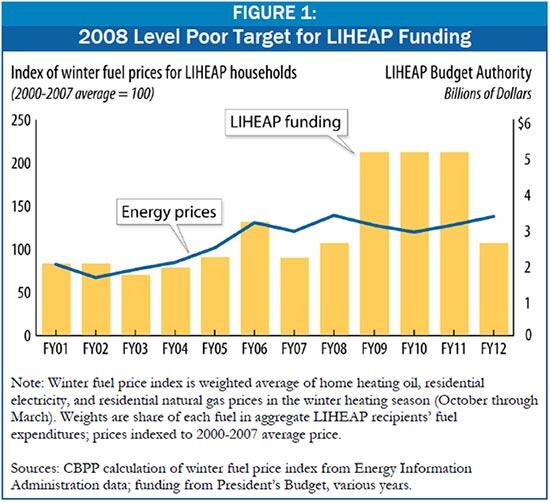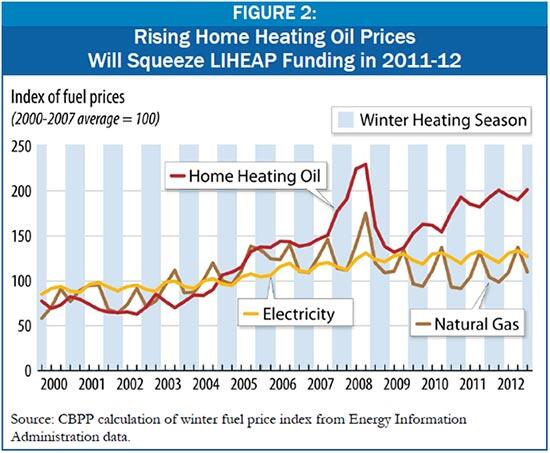- Home
- Administration’s Rationale For Severe Cu...
Administration’s Rationale for Severe Cut in Low-Income Home Energy Assistance Is Weak
The President’s 2012 budget proposes cutting funding for the Low Income Home Energy Assistance Program (LIHEAP) from the $5.1 billion enacted for 2010 to just $2.57 billion, a 50 percent reduction. The Administration’s rationale is that Congress sharply increased LIHEAP funding for fiscal year 2009 in response to a substantial energy price spike in 2008, and that the proposed cut merely “returns LIHEAP funding to historic levels received for 2008 prior to the energy price spikes.” As the following analysis shows, however, this rationale is unpersuasive in three respects.
- Funding for LIHEAP in 2007 and 2008 had fallen behind increases in energy prices, making the 2008 funding level a poor standard for next year’s funding level. (See Figure 1.)
- While the Administration correctly notes that home energy prices are lower now than when they peaked in mid-2008, the prices that matter most for LIHEAP are those in the winter heating season. Department of Energy forecasts show that next winter these prices will be back to their 2007-2008 levels and will be higher than in any other winter heating season in the 2000-2010 period.
- As a result of the 2007-2009 recession and the sharp increase in poverty and unemployment, the number of low-income households eligible for and needing home energy assistance in 2012 will be much larger than it was in 2008.
Thus, cutting LIHEAP back to 2008 levels would significantly shrink the already-low percentage of eligible low-income households that the program would be able to help. Put another way, cutting LIHEAP back to 2008 levels would mean a sharp reduction in LIHEAP’s effectiveness, not a return to “normal.”
Overview of LIHEAP and Its Funding
LIHEAP is a block grant that funds programs run by states, tribes, and territories to help low-income families pay their heating and cooling bills. Federal guidelines state that households must have incomes at or below 150 percent of the poverty line or 60 percent of state median income (whichever is higher), but states can set lower limits. States also determine who receives assistance out of the limited funding provided by the block grant. In 2006, the year with the largest funding prior to 2009, about 34 million households were eligible under the federal guidelines but only about 5.5 million received heating or winter crisis assistance, while another half million received cooling assistance. [1]

Figure 1 compares LIHEAP funding (budget authority) over the past decade to an index of home energy prices in the winter heating season (October through March). CBPP constructed the index from Energy Department data and projections for home heating oil, residential electricity, and residential natural gas prices, weighted by each fuel’s share of total fuel expenditures among LIHEAP recipients. The index measures the average price paid by LIHEAP recipients in each winter heating season relative to the average price of these fuels over the 2000-2007 period.
As Figure 1 shows, LIHEAP funding rose roughly in line with energy prices from 2001 to 2006 but dropped below the 2006 level in 2007 and 2008, even though energy prices remained high. When energy prices spiked in the spring and summer of 2008, Congress responded by significantly increasing LIHEAP funding for 2009. Energy prices fell sharply soon afterwards as the recession worsened.
Figure 1 shows the relationship between LIHEAP funding and energy prices in the winter heating season. It does not show the impact of the deteriorating economy and rising unemployment and poverty after 2008 on the number of households likely to need assistance, which we discuss further below. The President’s budget proposes cutting fiscal year 2012 funding back to 2008 levels. [2] That level of funding was inadequate in 2008 compared with the relationship between energy prices and funding in previous years; it will be even more inadequate in 2012 with energy prices rising and many more needy households.
Home Energy Prices on the Rise
Our analysis focuses on home energy prices in the winter heating season because the bulk of LIHEAP spending goes to home heating. As Figure 1 shows, an index of these prices peaked in the 2007-2008 winter heating season (the first six months of fiscal year 2008). Figure 2 provides more detail on the individual prices in the index shown in Figure 1.

As Figure 2 shows, home heating oil prices spiked in the spring and summer of 2008, sharply increasing home energy prices. It is understandable that Congress, which was deliberating LIHEAP funding levels for fiscal year 2009 while this spike was occurring, increased funding more than it otherwise might have.
Figure 2 also shows, however, that electricity prices are as high now as they were in 2008 (taking into account the distinct seasonal pattern of electricity prices) and that home heating oil prices are rising and are projected to keep rising into the 2012-2013 winter heating season. Compared to their average level in 2000-2007, home heating oil prices are now nearly twice as high, electricity prices are nearly 30 percent higher, and natural gas prices are over 10 percent higher. While these prices are lower than they were at their peaks in mid-2008, they are still higher than in the pre-2009 period whose LIHEAP funding levels the Administration wants to re-establish.
The Number of Households in Need Is Much Higher than in 2008
The Administration’s proposed cut also fails to account for the rise in poverty since 2008. In 2009, as the recession took hold, the number of poor persons rose by 3.7 million or 9 percent, by official estimates. The annual unemployment rate leapt from 5.8 percent in 2008 to 9.3 percent in 2009.
By 2012, moreover, the population in poverty is likely to have grown even more. According to CBO, unemployment is projected to be 8.4 percent in 2012, still well above its 2008 level. Poverty tends to rise following increases in the unemployment rate and does not start to decline until after the unemployment rate has started to fall. From 2008 to 2009, when the unemployment rate rose 3.5 percentage points, the official poverty rate rose 1.1 percentage points. If not for the poverty-cushioning impact of unemployment benefits — which increased rapidly in 2009, due in large part to temporary emergency unemployment programs enacted by Congress — the increase in the poverty rate would have been even larger, about 1.9 percentage points.
If this relation between poverty rates and unemployment continues and the U.S. population continues to grow at nearly 1 percent annually, the number of Americans in poverty will be roughly 15 percent higher in 2012 than it was in 2008. Some estimates are even higher: a September 2010 Brookings analysis projected that the poverty rate could reach 15.3 percent in 2012, putting the number of poor Americans 20 percent higher than in 2008.
With home energy prices during the winter heating season as high as they were in 2008 and a population in need that is 15-20 percent higher, the President’s proposed LIHEAP funding level would serve a much lower percentage of households than were served prior to 2009.
Conclusion
If the Administration’s goal in cutting LIHEAP funding back to the 2008 level is to restore “normal” funding levels to a program that received a large increase in 2009-11, it has missed the mark. Home energy prices in the fiscal year 2012 winter heating season are expected to be about the same as they were in the fiscal year 2008 winter heating season — not noticeably lower, as the Administration’s rationale for the cut implies. In addition, the population in need of energy assistance will be considerably larger in 2012 than it was in 2008. For all these reasons, establishing the 2008 funding level as the baseline for LIHEAP in 2012 will leave a higher percentage of the eligible population unserved or underserved than in 2008 or prior years.
End Notes
[1] Congressional Research Service calculations based on Department of Health and Human Services data. See Libby Perl, The Low-Income Home Energy Assistance Program (LIHEAP): Program and Funding, Congressional Research Service, August 27, 2009 and U.S. Department of Health and Human Services, Administration for Children and Families, LIHEAP Home Energy Notebook for Fiscal Year 2006, August 2008.
[2] The House Republicans have proposed eliminating the LIHEAP Contingency Fund for the remainder of FY2011 — emergency funding to supplement regular LIHEAP block grants, especially to states with particularly high home energy assistance needs. The Administration proposal would reduce the funding available for state block grants in FY2012 but would leave the Contingency Fund at roughly the same level as in FY2010.
More from the Authors


